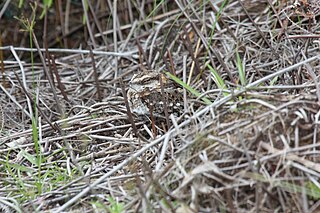
The lesser swallow-tailed swift or cayenne swift is a resident breeding bird from southern Mexico and Tobago south to Ecuador, eastern Peru and Brazil.

The pale-vented pigeon is a large pigeon found in the tropical Americas. Formerly often placed in Columba, it actually belongs to a clade of the older New World genus Patagioenas. With its relatives it represents an evolutionary radiation extending through most of the warm-temperate to tropical Americas. Grey-hued birds, even their males generally lack iridescent display plumage, although the present species has some coppery gloss on the nape.

The green ibis, also known as the Cayenne ibis, is a wading bird in the ibis family Threskiornithidae. It is the only member of the genus Mesembrinibis.

The white-tailed nightjar is a species of nightjar in the family Caprimulgidae. It is found in the Netherlands Antilles, Barbados, Brazil, Colombia, Costa Rica, Ecuador, French Guiana, Guyana, Martinique, Netherlands Antilles, Panama, Suriname, Trinidad and Tobago and Venezuela. Its natural habitats are subtropical or tropical seasonally wet or flooded lowland grassland and heavily degraded former forest.

The golden-sided euphonia is a species of bird in the Fringillidae family. It is found in Brazil, French Guiana, Guyana, Suriname, and Venezuela. Its natural habitat is subtropical or tropical moist lowland forests.

Dioscorea cayennensis subsp. rotundata, the "white yam", sometimes sold as "Guinea yam" or "white ñame", is a subspecies of yam native to Africa. It is one of the most important cultivated yams.
Stigmaulax cayennensis is a species of predatory sea snail, a marine gastropod mollusk in the family Naticidae, the moon snails.
Stigmaulax is a genus of predatory sea snails, marine gastropod mollusks in the family Naticidae, the moon snails.

Stachytarpheta cayennensis is a species of flowering plant in the verbena family known by many English language common names, including blue snakeweed, Cayenne snakeweed, dark-blue snakeweed, bluetop, nettle-leaf porterweed, rattail, rough-leaf false vervain, blue rat's tail, Brazilian tea, Cayenne vervain, false verbena, joee, nettleleaf velvetberry, and Cayenne porterweed. Names in other languages include honagasō (Japanese), gervão-urticante, piche de gato, rabo de zorro (Spanish), herbe á chenille, herbe bleue, queue de rat (French), ōi, ōwī (Hawaiian), and tiāki (Māori). It is native to the Americas, from Mexico south through Central and South America to Argentina, as well as many islands of the Caribbean. It is known in many other parts of the world as an introduced species, including regions in Africa, India, Indonesia, Australia, Florida in the United States, and many Pacific Islands. Its distribution is now considered pantropical. In many places it has become an invasive species.
Desmiphora is a genus of longhorn beetles of the subfamily Lamiinae, containing the following species:
Desmiphora amioca is a species of beetle in the family Cerambycidae. It was described by Galileo and Martins in 1998. It is known from Brazil.
Desmiphora neoflavescens is a species of beetle in the family Cerambycidae. It was described by Galileo and Martins in 1998. It is known from Brazil.
Desmiphora fasciola is a species of beetle in the family Cerambycidae. It was described by Martins and Galileo in 1995. It is known from Peru.
Desmiphora obliquelineata is a species of beetle in the family Cerambycidae. It was described by Breuning in 1948. It is known from Brazil.
Desmiphora picta is a species of beetle in the family Cerambycidae. It was described by Breuning in 1943. It is known from Argentina.
Desmiphora jullienae is a species of beetle in the family Cerambycidae. It was described by Tavakilian and Néouze in 2004. It is known from French Guiana.
Desmiphora kawensis is a species of beetle in the family Cerambycidae. It was described by Tavakilian and Néouze in 2004. It is known from French Guiana.
Desmiphora apicata is a species of beetle in the family Cerambycidae. It was described by Thomson in 1868. It is known from Brazil and Ecuador.

Desmiphora fasciculata is a species of beetle in the family Cerambycidae. It was described by Olivier in 1792. It is known from Brazil, Bolivia, Ecuador, French Guiana, and Mexico.
Desmiphora travassosi is a species of beetle in the family Cerambycidae. It was described by Mendes in 1938. It is known from Brazil.









